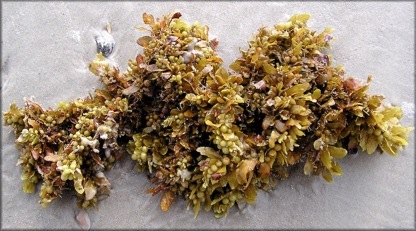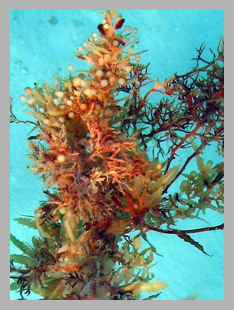Sargassum: Not Just for Breakfast Any More
Sargassum — Gulf weed — comprises a huge number of seaweeds in all oceans, both bottom dwelling and free floating. In fact, two common species found in Florida waters, S. natans and S. fluitans, are free floating all their lives.
This brown seaweed, which is also a vast floating masses in the Sargasso Sea in the north central Atlantic, is found washed ashore on the beaches often following sustained easterly winds such as during northeasters and hurricanes. It’s not only common in Florida but I also picked it up as a boy along the shores of New England. Although considered a smelly nuisance by beach-goers when it starts to decompose, the floating mats are a source of food or home to a huge variety of sea life. Often some of them will still be living on a clump of beached sargassum.
Species of Sargassum (sah-GAS-um) can be very difficult to identify because there’s a lot variability. But they do have some basic characteristics. Of all the seaweeds, Sargassum is the genus that looks the most like land plants. It has an axis (stem) with distinct foliar blades (leaves.) These “leaves” are long, oval-shaped, and may have smooth or toothed edges. In addition, Sargassum has small berry-like air bladders all over it. A member of the brown seaweed clan, its color doesn’t change much either, varying from yellow-brown to deep chocolate color. Avoid any seaweed. Sargassum or otherwise, with blue-green algae on it.
As one might expect Sargassum species vary in taste and texture so there is no one way to cook your local species. It takes experimentation. More so, among seaweeds Sargassum is not a prime edible but a plentiful one. Slightly bitter, one might call it an acquired taste, then again all tastes are acquired except that for sugar. As Asian countries have the most experience with eating seaweed, most of the approaches have an Oriental spin.
Some Sargassums are consumed fresh, others cooked in coconut milk or a little vinegar or lemon juice. It is smoked-dried to preserve it. Sargassum is also eaten by itself or added to fish and meat dishes. If not strong it can be added to salads after washing, or it can be cooked in water like a vegetable. If the Sargassum is strong flavored it can be boiled in two changes of water. Some recipes then call for it to be mixed with brown sugar and used as a filling in steamed buns but it could be eaten as is.
A second way of cooking Sargassum, such as S. fusiformis, is fry it quickly then simmer it in water with soy sauce and other ingredients for 30 minutes to two hours or more, depending upon the dish. Other areas of the world mix their Sargassum with oil, salt and green onions and using as filling in dumplings. It is also often cooked with tofu. One Fuji dish is to cook it with a fish then let it cool. When it sets it is sliced and eaten as a cold dish.
Indonesians like to drop Sargassum into boiling water and cook it for one minute then eat it with a sauce made with allspice. Or, they eat it with sugar or make it into a relish. Another option is to steam the seaweed. It can also be cooked into a jelly, firmed, and or used as a glue. Larger “leaves” make a chip when deep fried or the entire plant can be coated with a tempura batter, deep fried and served with a dipping sauce. Research shows that sargassum can collect large amounts of arsenic. Harvest carefully from clean waters.
Hawaiians had a variety of Sargassums to cook with. They stuffed fish with the leaves, or ate it raw with raw fish or octopus. The leaves can be added to soups and chowders or deep fried in tempura batter. Sun dried leaves can be eaten like chips, or they can be fried and sprinkled with salt.
Species found in Florida include: S. natans, S. fluitans, S. filipendula and S. pteropleuron. Those eaten elsewhere in the world include: S. aquifolium, S. fusiformis, S. granuliferum, S. mutica, S. polycyctum, and S. siliquosum. It can be cooked in coconut milk, or a little vinegar, or smoke dried.
As for the botanical name, the bladders look like grapes and were named Sargassum from the Portuguese word for grapes. Nutans (NEW-tanz) means nodding, and fluitans (FLOO-ih-tanz )from the Greek word fluito, floating. I suspect that is where the word “fluid” came from in English.
Green Deane’s “Itemized” Plant Profile
IDENTIFICATION: Locally, S. nutans long narrow leaves and pointed air bladders, S. fluitans broad leaves and air bladders without pointed tips. In the northeast U.S. any bottom attached Sargassum will be the S. filipendula.
TIME OF YEAR: All year, but is more plentiful in warm weather. In Florida winds and currents typically wash Sargassum to shore beginning in May. On the west coast of the U.S., spring to autumn.
ENVIRONMENT: S. nutans and S. fluitans are free floating. Other Sargassum are found just below the low water mark down to around 100 feet.
METHOD OF PREPARATION: Take younger leaves. Fried, boiled, steamed, dried.
HERB BLURB
Sargassums contain antibacterial fatty acids, has anti-oxidants and is mildly diuretic. Fresh Sargassum can be made into a poultice for cuts. In Chinese medicine Sargassum is dried, powered, and used to make a tea to control phlegm. Avoid Sargassum if you are iodine sensitive.



